Caring for Your Dog's Eyes
A Home Care Guide for Pet Parents s
On platforms like Reddit, Facebook pet groups, and various dog forums, discussions about canine eye issues are constant. Many dog owners struggle with their furry friends’ eye problems. Today, DogProfs is here to share some insights and solutions.
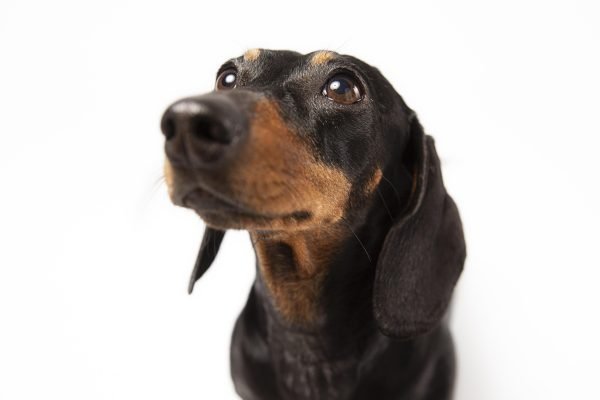
Common Dog Eye Problems & How to Address Them
Here are some of the most frequent eye issues dog owners encounter
Tear Stains
The Problem: Many light-colored dogs, especially Maltese, Bichon Frise, and Shih Tzus, often develop unsightly reddish-brown tear stains under their eyes. This isn’t just a cosmetic issue; it can also indicate bacterial growth or tear duct blockages. Dogs that spend a lot of time outdoors, like Golden Retrievers and Labrador Retrievers, are also prone to eye irritation from sand, dust, grass seeds, or even eyelashes getting into their eyes, leading to redness and tearing.
DogProfs’ Analysis: Tear stains are mainly caused by the oxidation and deposition of porphyrins in tears, excessive tear production, blocked tear ducts, entropion/ectropion (eyelid abnormalities), or allergies. A consistently moist environment can also promote the growth of bacteria and yeast.
- DogProfs' Advice
Daily Cleaning: Gently wipe the tear stain area daily using pet-specific eye wipes or a cotton ball soaked in saline solution. Always avoid using human eye drops or products with irritating chemicals.
- Trim Fur: Regularly trim the long hair around the eyes to prevent it from irritating the eyes or absorbing tears.
- Rule Out Underlying Causes: If tear staining is severe or accompanied by other symptoms (like red eyes or abnormal discharge), we recommend a vet check-up to rule out underlying issues like tear duct blockages, ingrown eyelashes, allergies, or infections. In some cases, your vet might suggest tear duct flushing or corrective surgery.
- Dietary Adjustments: Some dogs might be sensitive to specific ingredients in their food, which can worsen tear stains. Try switching to a high-quality, additive-free dog food or an hypoallergenic formula.
Excessive or Abnormal Discharge
The Problem: Normally, dogs have a small amount of clear or slightly whitish discharge, especially when they first wake up. However, if the discharge is yellow, green, or significantly increased in volume, it’s usually a sign of infection.
Symptoms:
- Small amount of clear or white discharge: This is common and usually normal, particularly when a dog wakes up.
- Large amounts of sticky, yellow, green, or bloody discharge: This suggests infection, inflammation, or irritation from a foreign object. It might also come with redness, swelling, and your dog scratching at their eyes.
DogProfs’ Analysis: Abnormal discharge typically signals bacterial, viral, or fungal infections (like conjunctivitis), allergic reactions, dry eye (Keratoconjunctivitis Sicca or KCS), or corneal damage.
- DogProfs' Advice
- For minor clear discharge: Just wipe it away daily with a pet-specific saline solution or warm water.
- For abnormal discharge: See your vet immediately! Do not attempt to use human eye drops or antibiotics. Your vet will examine discharge samples and perform tests like fluorescein staining to diagnose the cause and prescribe appropriate medication (e.g., antibiotic eye drops/ointment, anti-inflammatory drugs).
- Managing Dry Eye (KCS): For breeds prone to KCS, like Cocker Spaniels and Shih Tzus, if the discharge is sticky and their eyes seem dry, your vet might prescribe medication to stimulate tear production.
Redness and Swelling
The Problem: A dog’s eyes appear red and swollen, which could indicate allergies, infections (like conjunctivitis), or more serious underlying eye conditions.
Symptoms: The whites of the eyes (sclera) are red and bloodshot, eyelids are swollen, and your dog might squint, be sensitive to light, or rub their eyes.
DogProfs’ Analysis: Redness and swelling are common signs of eye inflammation, which can be caused by various factors, including: conjunctivitis (bacterial, viral, allergic), corneal damage (scratches, ulcers), glaucoma, uveitis, or a foreign object in the eye.
- DogProfs' Advice
- Initial Check: Gently pull back your dog’s eyelid to check for any obvious foreign objects. If you see a small piece of debris (like dust), you can try flushing it out with a pet-specific saline solution. If the object is large, embedded, or you can’t remove it, do not force it!
- Seek Immediate Vet Care: Regardless of whether there’s a foreign object, if your dog’s eye is persistently red, swollen, or they seem to be in pain, take them to the vet right away. Delaying treatment can lead to more severe consequences, especially with glaucoma and corneal ulcers, which can cause permanent blindness.
- Prevent Rubbing: Stop your dog from rubbing their eyes; you can temporarily use an Elizabethan collar.
Squinting, Light Sensitivity, or Frequent Blinking
Symptoms: Your dog’s eyes are partially closed, pupils are sensitive to light and avoid it, or their blinking frequency is abnormally high.
DogProfs’ Analysis: These symptoms usually indicate that your dog is experiencing pain or discomfort in their eyes, potentially due to corneal damage (like an ulcer), glaucoma, uveitis, or increased intraocular pressure.
- DogProfs' Advice
- Emergency Vet Visit: These symptoms are an ophthalmic emergency. If left untreated, corneal ulcers can perforate, and glaucoma can cause irreversible optic nerve damage in a short time.
- Minimize Stimulation: Before your vet visit, try to keep your dog in a dimly lit, quiet environment to reduce stimulation.
Eye Cloudiness or Color Change
Symptoms: The pupil (usually black) appears grayish-white, bluish, or hazy.
DogProfs’ Analysis:
- Older Dogs: Lenticular Sclerosis is common in older dogs, where the center of the lens appears bluish-gray but usually doesn’t affect vision.
- Cataracts: The lens becomes opaque, leading to decreased vision or blindness. Common in Cocker Spaniels, Golden Retrievers, Labrador Retrievers, Poodles, and Schnauzers.
- Glaucoma: High pressure inside the eye causes corneal edema, resulting in a bluish cloudiness.
- Corneal Edema: Caused by corneal damage or endothelial dysfunction.
- DogProfs' Advice
- Vet Examination: Any abnormal change in eye color should be thoroughly examined by a veterinarian to distinguish between normal aging and a condition that requires treatment.
- Cataracts: Early detection allows for monitoring, while advanced cases affecting vision may require surgical treatment.
- Glaucoma: This is an emergency that requires immediate medication to lower eye pressure and save vision.
Other Breed-Specific Eye Issues
Pugs and French Bulldogs, with their prominent eyeballs, are more susceptible to trauma and “dry eye” (KCS).
Cocker Spaniels are prone to glaucoma and cataracts.
Schnauzers can often develop fatty deposits and eye tumors.
Specific Care Tips for Common Breeds
Tear Stain-Prone Breeds
Maltese, Bichon Frise, Shih Tzu
Beyond daily cleaning, you can try some pet-specific oral tear stain supplements (like those containing cranberry extract), but always use them under veterinary guidance. Keep the fur around their eyes neatly trimmed to prevent long hairs from irritating the eyes. Pay attention to their diet; some dog food ingredients can worsen tear stains, so consider switching to a hypoallergenic formula.
Brachycephalic Breeds
Pug, French Bulldog
Due to their prominent eyes, they are more susceptible to injury. During play, try to avoid activities that could lead to eye trauma. Regularly check for dry eye symptoms (like dry, sticky discharge). If suspected, see a vet promptly; they might prescribe eye drops. Avoid prolonged exposure in windy or dusty environments.
Active Breeds
Golden Retriever, Labrador Retriever
lways check their eyes for foreign objects after outdoor activities. If your dog loves playing in tall grass, consider trimming the fur around their eyes to reduce the chance of debris getting stuck.
Long-Haired Breeds
Cocker Spaniel, Afghan Hound
Regularly trim the hair around their eyes to prevent it from irritating the eyes or obstructing vision. Long hair can easily pick up dust and dirt, so be extra thorough during cleaning.
Prevention is Key
DogProfs' Strong Reminder Beyond the specific care tips above, DogProfs strongly emphasizes that daily prevention is better than treatment.
- Gentle Cleaning
- Daily Check: Take a few minutes each day to check your dog’s eyes for discharge, foreign objects, or redness.
- Specialized Products: Use pet-specific saline solution or eye cleaning solution with clean cotton balls or wipes. Gently wipe from the inner corner of the eye outwards.
- Avoid Irritants: Do not use human eye drops, soapy water, or alcohol to clean your dog’s eyes.
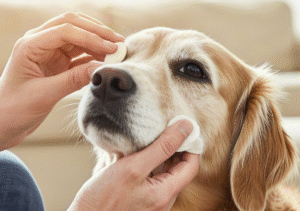
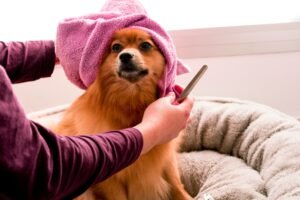
- Trim Hair Around Eyes
For long-haired breeds like Shih Tzus, Poodles, and Maltese, regularly trim the hair around their eyes to prevent it from irritating their eyes, obstructing their vision, or accumulating dirt and tear stains. You can seek help from a professional groomer.
- Avoid Irritants
- Stay Away from Smoke and Harsh Chemicals: Avoid smoking indoors, and ensure your dog isn’t nearby when using cleaning products.
- Bathing Protection: When bathing your dog, use pet-specific shampoo and be careful to avoid getting suds in their eyes.
-300x200.jpg)
-300x200.png)
- Nutritional Support
- Choose high-quality, balanced dog food rich in Omega-3 fatty acids (DHA/EPA) and antioxidants (like Vitamins C, E, Lutein, Zeaxanthin), as these contribute to good eye health.
- Certain specific supplements (such as those containing bilberry or grapeseed extract) might benefit eye health, but always use them under veterinary guidance.
- Regular Vet Check-ups
- Take your dog for a comprehensive veterinary check-up at least once a year, which should include an eye examination.
- For breeds with a family history of eye diseases (e.g., Cocker Spaniels are prone to glaucoma and cataracts; Golden Retrievers are prone to pigmentary uveitis) or senior dogs, more frequent eye exams might be necessary.
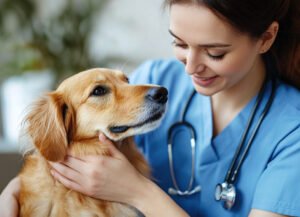
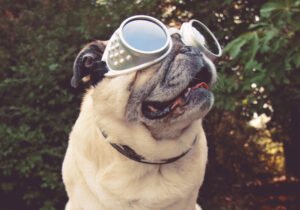
- Outdoor Protection
When your dog is in windy, dusty, or pollen-heavy environments, consider using dog-specific goggles, especially for prominent-eyed breeds like Pugs and French Bulldogs. These can effectively prevent foreign objects from entering the eyes or irritation from wind and dust.
